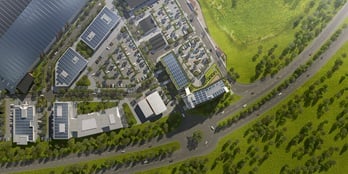How tech disruption is reshaping the construction site of tomorrow
By proceeding you confirm that you are a resident of Australia or New Zealand accessing this website from within Australia or New Zealand and you represent, warrant and agree that:
- you are not in the United States or a “U.S. person”, as defined in Regulation S under the U.S. Securities Act of 1933, as amended (“U.S. Person”), nor are you acting for the account or benefit of a U.S. Person;
- you will not make a copy of the documents on this website available to, or distribute a copy of such documents to, or for the account or benefit of, any U.S. Person or any person in any other place in which, or to any other person to whom, it would be unlawful to do so; and
- the state, territory or province and postcode provided by you below for your primary residence in Australia or New Zealand are true and accurate.
Unfortunately, legal restrictions prevent us from allowing you access to this website. If you have any questions, please contact us by e-mail by clicking on the link below.
The building construction site has been one of the last parts of the property sector to hold out against tech disruption. But that is now changing rapidly as businesses in the building industry realise they too can gain competitive advantages from innovative technologies that drive up efficiency and profitability.
Around the world, a new generation of start-ups are tackling the construction sector’s biggest pain points. In the first half of 2018 alone, venture capital firms globally invested over $US1 billion in construction technology.
As a result, the industry is now at the cusp of a new era that will see changes in every phase of the construction process, from design and estimation through to the management of sites, materials and labour and the mechanics of erecting structures, boosting productivity, safety and quality.
Sujeet Rana is Chief Digital Officer of national construction firm Built, which has partnered with Charter Hall on numerous projects including the recently completed Raine Square retail precinct revitalisation in Perth, and the GPO Exchange building in Adelaide, scheduled for handover in 2019.
Rana says while the construction industry may have fallen behind in tech innovation, it is now working hard to catch up:
“For example at Built we have created our own digital/innovation lab, Built Labs, which has been operating since March. Its focus is on using digital and construction technology to transform the way that we operate on a day-to-day basis, allowing us to build faster, with better quality and higher safety than ever before".
We are also working on increasing transparency in our supply chains and in our relationships with everyone, from subcontractors all the way up to national clients like Charter Hall.’’
At Raine Square, Built deployed several new technologies including Built Exchange, a system developed in-house that allows the company to tender, compare and award subcontracts in a much more efficient way than ever before.
“It allows our subcontractors to interact with us directly through a portal, replacing spreadsheets and some very complicated processes that have now all been digitised,’’ says Rana. “We have over 1,400 subcontractors on that system at the moment.’’
-how-tech-disruption-is-reshaping-the-construction-site-of-tomorrow.jpg?sfvrsn=1e71390b_2)
Rana notes that Raine Square was also the first Built development where all construction documentation was stored on the cloud. It also used new software produced by Australian start-up Lucidity to manage site safety using mobile devices.
At the GPO Exchange development, Built is deploying business information modelling (BIM), which gives architects, engineers and builders the ability to more efficiently plan, design, construct and manage buildings.
“BIM is a way of creating a 3D model or a digital twin that is a virtual representation of the physical building,’’ says Rana.
“We map that down to the smallest details, which allows us to work really closely with contractors, consultants and architects who are all working off the same plan in real time. And as those plans change, everyone is kept aware of what those changes are.
“This allows significantly more coordination and collaboration, both on site and interstate.’’
Rana believes the biggest opportunities going forward in construction technology are around machine learning and predictive analytics.
“In the future, building sites will generate enormous amounts of data, but that becomes useful only when you can turn it into insights. Machine learning and predictive insights allow large quantities of data to be converted into useful information, so you start to get a real-time view of what is happening on site.’’
He also sees great potential for distributed ledger technology (DLT), or blockchain, given the industry’s heavy reliance on complex supply chains that can stretch around the world.
“DLT will really ensure that there is clear accountability of handoffs, on where materials are, how they are transported, whether they have arrived in the right location and been paid for. This will eliminate a lot of guesswork and manual processes from supply chains,’’ he says.
With so many rapid developments on so many fronts simultaneously, it is difficult to predict what the construction site of the future may look like. For example, 3D concrete printing is an exciting area of exploration in construction, while at Charter Hall they are collaborating with start-ups on the use of virtual reality and augmented reality, which may soon enable construction workers to ‘see’ through walls, and reveal the layout of piping and wiring under floors.
Some experts have predicted that robotics may one day replace human labour on the building site, ushering in new standards in productivity and safety. However Rana believes this is still a long way off and will likely be limited.
“Robotics works very well with indoor manufacturing, and may soon have a big role to play in prefab and modular, but construction sites, with unstable conditions such as weather etc, are far more dynamic,’’ he says.
“Nonetheless the pace of technological innovation is one of the most exciting parts of working in this sector today and it will continue to yield positive outcomes in the future.’’


